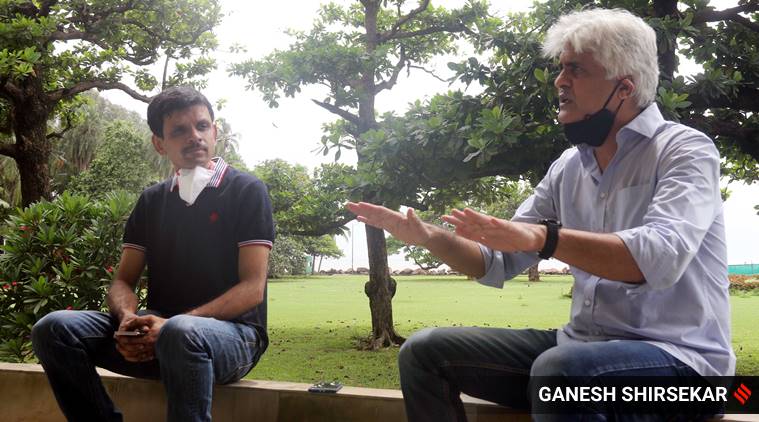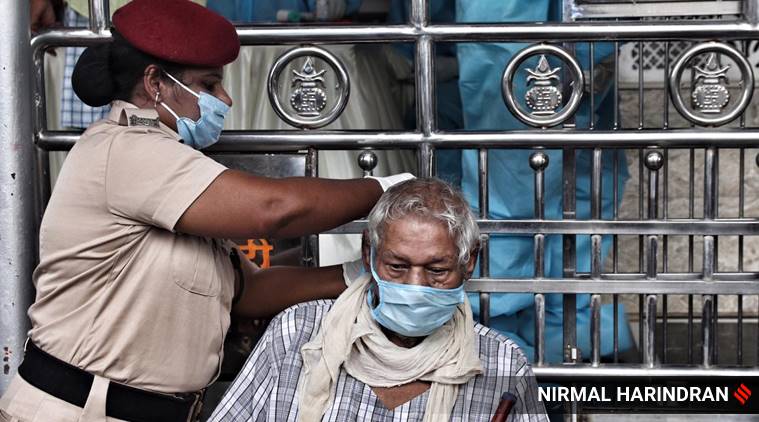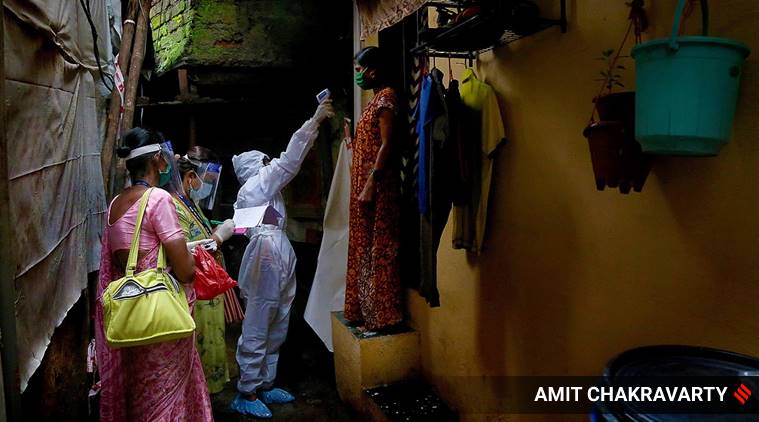 Professor Dr Ullas Kolthur Seetharam and Professor Sandeep Juneja at Tata Institute of Fundamental Research in Mumbai on Wednesday. (Photo by Ganesh Shirsekar)
Professor Dr Ullas Kolthur Seetharam and Professor Sandeep Juneja at Tata Institute of Fundamental Research in Mumbai on Wednesday. (Photo by Ganesh Shirsekar)
Professor Dr Ullas Kolthur Seetharam and Professor Sandeep Juneja, Dean of School of Technology and Computer Science, at the Tata Institute of Fundamental Research (TIFR), discuss Mumbai’s sero survey which they conducted along with BMC and Niti Aayog and its implications. Excerpts from an interview with The Indian Express
The sero survey in Mumbai covers only about 7,000 people. Similar surveys in Delhi covered 21,387 people and in Spain 61,075 people. Don’t you think 7,000 may not represent whole of Mumbai with its 18 million population?
Sundeep Juneja: We are only sampling three wards, so we can’t claim to represent entire Mumbai. For all we know other wards may have entirely different findings. But we have adequate numbers from these three wards. by restricting ourselves to slums and non-slums in three wards, we restrict the geographical variation, so that with the data we have, our estimate of prevalence is statistically reasonable. In slums our estimate of 57 percent seropravalence may have a plus-minus of 2-3 percent statistical error.
Seroprevalence in the slums of three wards was 50 to 60 per cent and in non slums, 11 to 18 per cent.
Dr Ullas Kultur Seetharam: Of course, numbers matter. But even within these wards, we looked at five slums that were spread out. We looked at random sampling that is representative of slums. We went to every fourth building in a non-slum to get a large area. This will still give you representation of the city. What could change our seroprevalence per cent is active containment zones. We deliberately left those out. If containment zones were included, the seroprevalence would have been higher. The only stark finding is difference we found in slums and non-slums, which would be uniform across the city.
What about behaviour pattern, did you measure the adherence to mask-wearing, hand hygiene and whether that played a role in exposure?
Juneja: We did not question people whether they wore masks or not. In slums, it is hard to maintain social distancing, they have common toilets. Economic constraints are more in slums, they have to step out to work so probably that is why they are exposed.
Seetharam: Yes, in non-slums people can work from home. In slums, even if they want to adhere to rules, they cannot possibly maintain social distancing.
What are you looking at in the next sero survey?
Juneja: We want to measure change in a month, how much has seroprevalence changed, what the infection rate is. We will visit the same areas, same wards.
Seetharam: We will sample a different population but in same areas. We want to do a deep dive, it is not possible to do that in such short time if we sample all wards in city. We will start from August 10, it will take two weeks to take samples and another week to analyse them.
Why or how do you think Mumbai has managed to reach seroprevalence of 40.5 per cent. The first case came on March 11. New York and Spain recorded cases much before and still have low prevalence.
Juneja: But if we look at non-slums in Mumbai, which has 16 per cent seroprevalence, there is not much difference between New York and Mumbai.
Seetharam: One could say that infection fatality rate is higher in New York and lesser in Mumbai (infection fatality is number of people dying against total infected). That needs to be studied, but any person getting infected in New York vis a vis Mumbai, there is less likelihood of dying, in Mumbai.
Why?
Juneja: Age is a factor. Indians are younger demographically. Even between slums and non-slums, our assumption is slum population is younger than non-slums.
 A police officer helps a man adjust his mask in Mumbai (Express photo/Nirmal Harindran)
A police officer helps a man adjust his mask in Mumbai (Express photo/Nirmal Harindran)
Have you advised any change in Covid strategy to BMC after this survey?
Seetharam: BMC has on its own changed its focus from slums to non-slums, because they were seeing more cases come from the non-slums even before this survey.
Juneja: Isolation of symptomatic people immediately is important. Using these numbers, they should focus on ensuring more beds are available. Because infection is still there. Such big numbers might scare, but what is more scary is not being able to get a bed. I think BMC should focus on that.
What about opening up the city?
Juneja: The economy is of concern. These numbers are reassuring, they tell us there will be no dramatic increase in numbers if we open the city a little bit. And we take it from there. If trains have to be opened up, it has to be very, very gradual. We have to see how the infection spreads.
Seetharam: When the economy is opened up, activities must be allowed in a less crowded environment. There are merits and demerits of lockdown, and that has to be weighed based on at what time point the disease is. There are socio-economic factors, logistics, which I am sure BMC will weigh.
Are there any projection models TIFR has worked on?
Juneja: We are working on that model. The big unknown is what happens if trains open up. That could change the projection a lot.
Did you look at comorbidity in this survey?
Juneja: Infection fatality rate is lower in slums than non-slums. One reason is that slum population is younger. One reason may be that slum populations are younger. Other reason may be that non-slum people also have more co-morbidities than slum dwellers. We will attempt to analyse these in our study.
Seetharam: We looked at whether people who were surveyed had respiratory illnesses, had co-morbidities and how many people live in a household. We will analyse household density data. We have to study all this.
 Health workers conduct a door-to-door survey in Chembur East area of Mumbai. (Express Photo: Amit Chakravarty)
Health workers conduct a door-to-door survey in Chembur East area of Mumbai. (Express Photo: Amit Chakravarty)
More women have been exposed than men. What could this mean?
Seetharaman: It could mean two things; there could be a difference in social behaviour, that women step out more than men to buy groceries or it could mean there is a biological difference in both genders. It is difficult to assess now.
Juneja: It could point to more robustness in women, that they are surviving this infection better than men.
This survey has raised hopes for herd immunity…
Seetharaman: Yes, but we don’t know how long that immunity will last or memory of infection will last. Evidence is only emerging on that. Our next sero survey will check if there is change in prevalence, this could provide answers to whether herd immunity can be achieved and when.
Was there difference in exposure rates to Covid-19 based on age?
Juneja: In slums, there was not much difference across age groups and exposure. The hypothesis is there is a lot of intermingling of population in slum, that could be one reason. In non-slums we found young people were more exposed than senior citizens. But it is a small trend, we need more data.